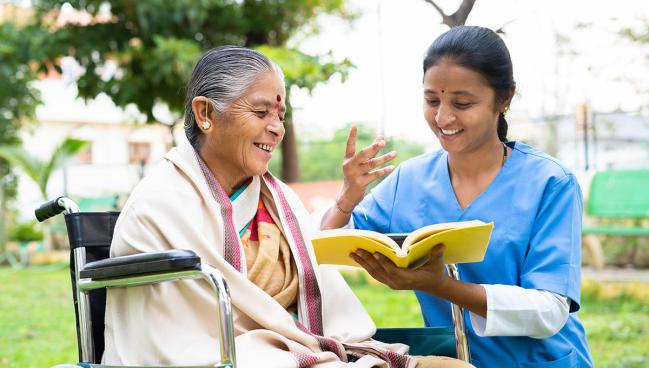Community Health Workers Boost BP Control in South Asian Immigrants
The study adds to mounting evidence in support of the approach for hypertension, this time in a particularly high-risk community.

Integrating community health workers into primary care practices improved the management of hypertension among South Asian immigrants living in New York City, researchers report.
Within Project IMPACT, patients who attended several educational sessions and received health coaching from community health workers were significantly more likely to have their blood pressure controlled after 6 months than were those who received usual care (68.2% vs 41.6%), a difference that remained significant after adjustment for a variety of factors (OR 3.7; 95% CI 2.1-6.5).
Several BP self-management behaviors and patient-reported outcomes improved with the intervention, as well, according to a team led by Nadia Islam, PhD (New York University Grossman School of Medicine, New York, NY).
“While evidence now has demonstrated that implementation of community-clinical linkage models in small practice settings can improve BP control, the engagement of primary care settings serving South Asian populations in such initiatives has been noticeably absent,” they write in a study published online Thursday in Circulation: Cardiovascular Quality and Outcomes. “Our findings provide support for models to enhance BP control using community health workers in small community-based practice settings for South Asian communities.”
Moreover, they say, the findings “can guide translation and dissemination of this model across other communities experiencing hypertension disparities.”
Project IMPACT
Study author Lorna Thorpe, PhD (New York University Grossman School of Medicine), noted to TCTMD that BP control is suboptimal in many racial/ethnic minority communities in the United States, including among Black and South Asian individuals. Although numerous studies have assessed the impact of community health workers in supporting BP control, an approach supported as part of the federal government’s Million Hearts initiative aiming to prevent 1 million MIs and strokes over the next 5 years, little research has been done in South Asians, who have particularly high risks of CVD, diabetes, and hypertension.
“Community health workers, frontline public health professionals, play an integral role in disseminating effective health interventions through their deep knowledge and connection to communities, cultivated through shared sociodemographic or cultural characteristics and trusted relationships,” the investigators explain. They “provide culturally-appropriate health education, assist in translation or interpretation, and advocate for individual and community health needs, providing vital social support and capacity-building to ensure sustainable health improvements in their communities.”
I think that’s what’s really the hallmark of community health workers—these are highly empathetic individuals who come from the same communities as the patients themselves. Lorna Thorpe
In Project IMPACT, Islam, Thorpe, and colleagues evaluated the utility of these workers when integrated into community-based primary care practices in New York City that largely serve South Asian immigrants. Across 14 clinic sites, the investigators recruited 303 patients (mean age 57 years; 54% women) who had diagnosed hypertension and uncontrolled BP (systolic ≥ 140 mm Hg or diastolic ≥ 90 mm Hg) within the past 6 months. All participants were foreign-born, with self-reported ancestry from India, Bangladesh, Pakistan, Nepal, Sri Lanka, or the Indo-Caribbean; they had been living in the US for an average of about 14 years.
The study involved seven community health workers—four men and three women—who spoke Bangla, Hindi, Punjabi, and/or Urdu.
After one education session, the patients were randomized to the community health worker intervention or usual care. The intervention involved four additional group education sessions each lasting 60 to 90 minutes along with individualized health coaching covering goals, treatment adherence, physical activity, and nutrition over a 6-month period.
At baseline, mean BP was 138/86 mm Hg; patients in the intervention arm were less likely to have their BP controlled to below 140/90 mm Hg (38% vs 42%).
That shifted after 6 months, however, with the rate of control rising by an absolute 30% in the intervention arm and remaining stable in the usual-care arm. At 6 months, mean BP was lower in the intervention arm than in the control arm for both systolic (134 vs 141 mm Hg) and diastolic (82 vs 88 mm Hg) readings. The positive effect on BP control was even more pronounced in the subset of patients with diabetes (OR 6.3; 95% CI 2.9-14.8).
The involvement of community health workers also led to improvements in various BP self-management activities, including cutting salt from the diet, reducing body weight, participating in a physical activity program, actively learning about healthy eating, and measuring one’s own BP. In addition, gains were seen in patient-reported measures of physical, mental, and general health, as well as performance of usual activities.
“The use of community health workers really helps patients who have suboptimal blood pressure control improve their control much more effectively than usual care practices,” Thorpe said.
These workers “help patients develop goals that are achievable and important to the part of their life that is making it hard to control their blood pressure,” she explained, citing issues like medication adherence, physical activity, and nutrition. “It depends on the patient, and I think that’s what’s really the hallmark of community health workers—these are highly empathetic individuals who come from the same communities as the patients themselves. They work closely with the patients through health-coaching sessions to set goals and then help them monitor and meet those goals over time.”
Implementation Challenges
Although the involvement of community health workers has now been shown to pay dividends for managing chronic diseases in a variety of settings, a major challenge to broader implementation is figuring out how to pay for the approach, Thorpe indicated. That can be difficult for smaller primary care practices out in the community.
“It’s really about: how do we build the sustainable approach to bringing community health workers into clinical environments where we’ve demonstrated there can be a big health impact?” she said, adding that despite some test efforts in New York and other states, there are no permanent ways to financially support the inclusion of community health workers in clinical offices.
There can and should be broader adoption of this. Jeremy Sussman
The resources needed to add community health workers to the clinical team are a barrier to wider adoption, acknowledged Jeremy Sussman, MD (University of Michigan, Ann Arbor), who was not involved in the study. He suggested, however, that the growing evidence of their benefits for patient care support finding ways to overcome the financial obstacles.
“The interest in using community health workers for chronic disease management has been growing in America for well over 20 years now, and it’s beginning to look like it’s reaching a turning point where this can start being something that gets used regularly in clinical practice,” Sussman commented to TCTMD.
Many patients with a chronic disease like diabetes or hypertension find daily management difficult, he said, “so having someone who they can know and trust, and who can simply spend more time with them than a doctor can, can make a big difference.”
The resources in terms of personnel, time, and money needed to get a community health worker program going shouldn’t be minimized, and there are remaining questions about scalability and how much programs need to be modified for specific communities, but, Sussman said, “there can and should be broader adoption of this. I think this is a valuable tool that we could be using in many settings right now.”
Todd Neale is the Associate News Editor for TCTMD and a Senior Medical Journalist. He got his start in journalism at …
Read Full BioSources
Islam NS, Wyatt LC, Ali SH, et al. Integrating community health workers into community-based primary care practice settings to improve blood pressure control among South Asian immigrants in New York City: results from a randomized control trial. Circ Cardiovasc Qual Outcomes. 2023;16:e009321.
Disclosures
- The study was supported by a grant from the Centers for Disease Control and Prevention. Islam’s time is partially supported by the National Institutes of Health, the National Institute of Diabetes and Digestive and Kidney Diseases, the National Institute on Minority Health and Health Disparities, the National Heart, Lung, and Blood Institute, and the National Center for Advancing Translational Science.
- Islam and Thorpe report no relevant conflicts of interest.





Comments